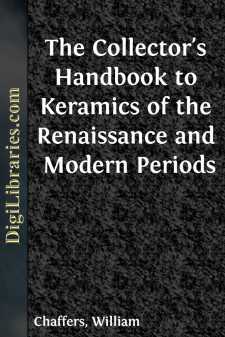Categories
- Antiques & Collectibles 13
- Architecture 36
- Art 48
- Bibles 22
- Biography & Autobiography 813
- Body, Mind & Spirit 142
- Business & Economics 28
- Children's Books 15
- Children's Fiction 12
- Computers 4
- Cooking 94
- Crafts & Hobbies 4
- Drama 346
- Education 46
- Family & Relationships 57
- Fiction 11828
- Games 19
- Gardening 17
- Health & Fitness 34
- History 1377
- House & Home 1
- Humor 147
- Juvenile Fiction 1873
- Juvenile Nonfiction 202
- Language Arts & Disciplines 88
- Law 16
- Literary Collections 686
- Literary Criticism 179
- Mathematics 13
- Medical 41
- Music 40
- Nature 179
- Non-Classifiable 1768
- Performing Arts 7
- Periodicals 1453
- Philosophy 64
- Photography 2
- Poetry 896
- Political Science 203
- Psychology 42
- Reference 154
- Religion 513
- Science 126
- Self-Help 84
- Social Science 81
- Sports & Recreation 34
- Study Aids 3
- Technology & Engineering 59
- Transportation 23
- Travel 463
- True Crime 29
The Collector's Handbook to Keramics of the Renaissance and Modern Periods
by: William Chaffers
Description:
Excerpt
ITALY
The painted pottery of Italy, ever since its introduction into that country in the 15th century, has been called by the Italians themselves Maiolica. In England it was in the 18th century called Raphael ware, on account of an impression which existed that Raphael himself condescended to paint on some of the ware. The idea probably originated from the fact that many designs were reproduced on maiolica by the keramic artists from engravings of Raphael and other great masters. The best period of this pottery was, however, subsequent to his death, which took place in 1520.
The term maiolica appears to be derived or rather corrupted from Maiorca, one of the Balearic Islands, noted for its pottery from a very early period. It was in the 16th century called Maiorica, and subsequently Maiolica.
Urbino was one of the most celebrated of all the Italian fabriques, and must have had by far the most trade, although no doubt many of the specimens now attributed to this city were the works of other manufactories; there are, however, a considerable number of signed and dated pieces, and the style and touch of the principal artists engaged there may easily be detected. The best known of all the keramic artists of Urbino was Francesco Xanto Avelli da Rovigo, whose works are now so highly appreciated; he usually painted after the designs and engravings of Raphael and other great masters, but seldom adhered strictly to the grouping of the originals; he also painted subjects from Virgil, Ovid, and other poets. The marks which he placed upon his works consisted of one or more initial letters of his name, F.X.A.R., but usually the X. only, or sometimes Xanto, with the date. (See Fig. 1.)
Fig. 1.âPlateau. Marriage of Alexander and Roxana.
After Raphael. Signed and dated âXanto, 1533.â
Fig. 2.âPlateau, with Leda and the Swan in Centre.
16th Century.
Another celebrated artist of Urbino, who flourished in the middle of the 16th century, was Orazio Fontana, whose family name was Pellipario; Fontana being a name taken in consequence of several of the family being manufacturers of vases as well as artists.
Fig. 3.âPlateau. By Alfonso Patanazzi, 1606.
The family of Patanazzi worked in the early part of the 17th century. Alfonso Patanazzi signed his pieces of the years 1606 and 1607 in full, as well as Alf. P. and A. P. (See Fig. 3.)
Fig. 4.âVase. Apollo and Daphne. Circa 1580.
Fig. 5.âCruet. About 1570.
GUBBIO
Gubbio, in the Duchy of Urbino, is known principally by the works of Maestro Giorgio Andreoli, who seems to have monopolised the secret of the ruby and yellow metallic lustre, with which he enriched not only his own productions but put the finishing touches in lustre on the plates of Xanto and other artists from Urbino, as well as from Castel Durante. There is no doubt that the painting of the piece and the application of the metallic lustre colours were two distinct operations, and that it was painted and the colours fixed in the muffle kiln some months before it was touched with the lustre pigments, and again subjected to another baking....


